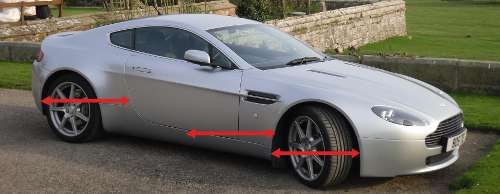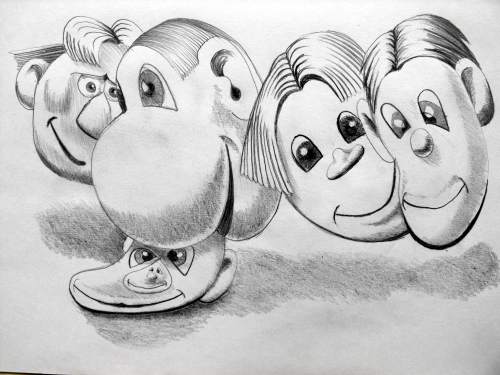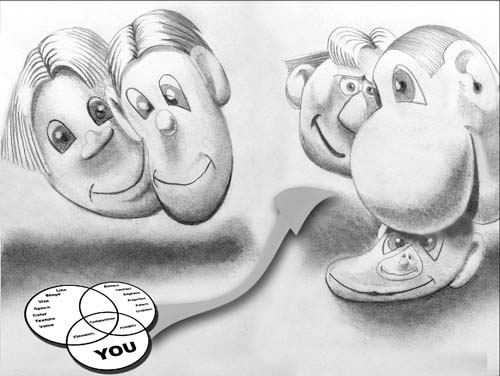The requirements are pretty basic for doing pencil art, pencil drawings, but there are a few essential things you really need know in order to do well.
Here is an overview of the basic kit with a few extras you will need.
Pencil sharpeners.
I personally prefer the old-style two hole metal pencil sharpener.
A receptacle sharpener which keeps the wood chips contained within it is perfect for keeping things tidy.
To reduce wastage and breakage, especially with pencils where the cores are poorly centered, many people prefer using a hobby knife instead of a sharpener. If you choose to use a knife then please remember to be very careful and always cut away from yourself. If you use a lot of pencils often then many people prefer to use a good electric pencil sharpener.
Emery paper.
Very fine emery paper is useful for keeping the point sharp whilst you’re doing a drawing. It can also be used to clean your paper blending stump or Tortillon as they are often called.
Blending equipment.
A tortillon is a tightly rolled paper shaft that is used as a blending stump for smudging and blending your drawings. Use a tortillon instead of your fingers for blending as skin oils will damage your drawing in time, turning it yellow in the areas where you have been blending, making your drawing patchy and irregular, it also makes your pencil marks more difficult to erase if you need to.
Rubber tip ‘color shapers, pastel blenders can be very useful for working other media enabling you to work small confined areas. Chamois leather is sometimes used for applying, lifting out and mixing media.
Kneadable Eraser.
A kneadable eraser is very useful tool for lifting and erasing all types of media. When a surface of the eraser becomes dirty you can stretch and fold it into a fresh clean surface area. The general rule is to use large pieces for large areas and smaller pieces for small areas, you can also shape it to suite your needs. Many people prefer to use “Blue Tack” or similar adhesive poster gum as well or as an alternative.
Plastic Erasers.
Good plastic erasers will be soft and smooth to touch – avoid the cheap ones they are usually crumbly or hard and often come with advertising logos imprinted on them. Mostly it is best to have more than one on the go at the same time because they get dirty, needing to be cleaned often so having more than one means you can have clean ones available when you need them. It is best to have clean ones to erase the light areas and highlights, they can be trimmed with a sharp knife to make a clean surface but again please be careful. Battery and electric erasers are now popular and they enable you to make precise spot erasing and rapid clearance of large areas.
Ruler, T-Square and Flexible Curve.
Drawing a framework around your drawing area will help you with your construction so that that you can better place your subject in the drawing area it also helps for developing better comparison to help work a complete composition as opposed to having your subjects just floating on the drawing surface and creates a border around the drawing that will help when you might come to frame the finished piece. A T-square and straight edged ruler are both important for doing perspective drawings so it is helpful to obtain these in different sizes that are more applicable to the size of the drawing you are doing. A flexible curve is not important, but is often very useful when wanting to create smooth repetitive curves and more so when drawing subjects that have been manufactured and are expected to be perfectly drawn.
The graphite pencil as humble as it may seem is the simplest of drawing tools ever, yet it is unmatched even with today’s technologic advances, but when you visit the arts shops you will be amazed by the massive variety of these simple tools that come in many different qualities, shapes and sizes. If you are a beginner just starting out then a cheap and cheerful option might be best with the quick solution being to choose each of the following grades, 6B, 4B, 2B, H and 2H of fairly good quality. A serious beginner might want to buy a full set in a case or even buy a range of mechanical clutch pencils that can also be found in different sizes and grades, experimentation will help you find what’s best for you.
Line grooving tools.
Many artists use metal tools for drawing groves into the pager to create fine white lines by then lightly shading over the top with a pencil this creates very fine white lines because none of the pencil goes into the groves but some use hard plastic knitting needles as well and for very fine line work you can use a large darning needle with a fairly bunt tip.
What are pencils made from?
Pencil cores are made of powdered graphite (this is not lead as might be assumed because many people still call them lead pencils) the graphite is fired with clay, which varies in different hardness. A relatively soft, malleable type of graphite is used in a pencil which resembles lead and when first discovered it was mistakenly believed to be a different form of lead. Many people still think that pencil cores where once made of lead but they never where, graphite leaves small, smooth particles when used on paper and has a slight sheen because it is reflective.
Pencil Quality Varies.
Pencils can vary greatly in quality. Often the irregularities in substandard or badly processed graphite will lead to unpredictable varying tonal range, and even worse unintentional groves and scratches into the paper surface. Un-centered cores have a tendency to break when sharpening but the better quality pencils deliver a more reliable even tone with carefully graded hardness and are less likely to break.
Wooden-cased Pencils.
These pencils vary in hardness from about 9b (very soft) to a 9H (very hard) depending on brand and most in the beginning will start with a selection ranging from 2H, HB, 2B, 4B and 6B as these are more than sufficient. If you want to be doing extremely fine realistic tonal work then you will want to try the full range of pencil grades that are graded from 9H to 9B you could buy these in a full set but 4H is the hardest pencil I use.
Clutch and mechanical pencils.
Mechanical clutch pencils are very useful the traditional wooden cased pencils change their size, weight and balance as they are used and sharpened, which can be a problem where as clutch pencils have a regular constant weight, size and shape, they where once expensive but nowadays they can be bought very reasonably and the refill graphite sticks come in quantity which makes the even less expensive. They are environmentally friendly because there is no wood in them and they always stay sharp when working with small sizes. They come in a range of varying diameters from 0.5 to 5+mm I prefer these pencils to all others because they are very practical.
Graphite sticks and crayons.
Graphite sticks are thick solid graphite pencils that have no wood casing but have a coating on the outside for handling without getting graphite all over your hands which can be very messy they are helpful when going for broad, expressive work and shadows over lines made with a grooving tool or when wanting a visible paper tooth for a desired effect. Graphite crayons are chunky much like crayons are they are suitable for big, energetic work but they are messy as they have no coating on the outside so easily rub off onto your hand especially the softer grades but are the best for doing tactile, involved mark making on a large scale work or life drawing.
Powdered Graphite.
Powdered graphite is a more hands-on drawing medium, that is often applied with the fingers or a cloth that can be used in drawing to produce soft, loose marks it is also used to make a drawing surface toned for lifting with an eraser.
Carbon Blends.
Carbon pencils are made with carbon black or lamp black which is soot gathered from burning oil, giving it a smooth, very dark black line with variations on this being mixtures of carbons such as charcoal and or graphite. Particles vary in size depending what is the mix, soot has fine particle so is smooth and gives a nice even particle, charcoal is often quite rough. Compressed Charcoal pencils and carbon will be useful when wanting to obtain a true black, which is not possible with graphite because it is never black enough and reflective, always test the compatibility of application before doing your drawing.
Pastel and chalk pencils.
The black conte pencil is made from mixing carbon black and alumina chalk this has is smoother and creamier in consistency than the pastel, you can get hard pastels in pencil format, the manufacturers constantly experiment with the different media. Pencils which are white are either wax coloring pencils or chalk pastel pencils these are made from different combinations of mixed pigment, clay, chalk, gum and wax these other mixed media pencils may not always be compatible in pencil art, pencil drawings with graphite , and you should try them out first on a small test area.
View Gareth Pritchard’s profile on G+





